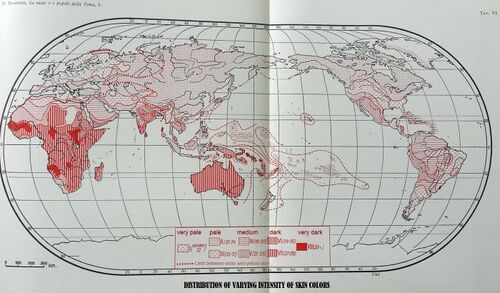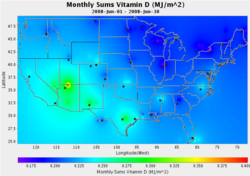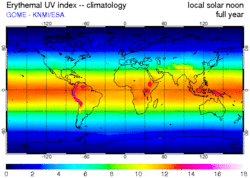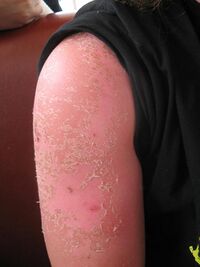Chemistry:Health effects of sunlight exposure
Exposing skin to the ultraviolet radiation in sunlight has both positive and negative health effects. On the positive side, exposure allows for the synthesis of vitamin D3. Vitamin D has been suggested as having a wide range of positive health effects, which include strengthening bones[1] and possibly inhibiting the growth of some cancers.[2][3] A dietary supplement can also supply vitamin D,[4] but there are also benefits to exposure not obtainable through Vitamin D supplementation. Long-term sun exposure is associated with reduced all-cause mortality and reduced mortality risk from cardiovascular disease (CVD), some forms of cancer, and non-CVD/noncancer related disease, with indications in these studies that Vitamin D is not the mediator.[5][6][7] Supplementation offers limited bioavailability and no synthesis of subdermal nitric oxide.[8][9] UV exposure also has positive effects for endorphin levels, and possibly for protection against multiple sclerosis. Abundant visible light to the eyes gives health benefits through its association with the timing of melatonin synthesis, maintenance of normal and robust circadian rhythms, and reduced risk of seasonal affective disorder.[10]
On the negative side, UV is a mutagen and carcinogen for skin.[11][12] Acute exposure may lead to a painful sunburn, which can increase the chances of developing serious skin problems later in life.[13] Long-term sunlight exposure is known to be associated with the development of some types of skin cancer, skin aging, immune suppression, eye diseases such as cataracts and maybe macular degeneration.[14][15]
Since UV rays, and therefore sunlight and sunlamps, have both health benefits and risks, a number of public health organizations state that there needs to be a balance between the risks of having too much sunlight or too little.[16] There is a general consensus that sunburn should always be avoided.
Vitamin D3 production
The only way to quantify adequate levels of vitamin D is with a serum 25(OH)D3 (calcifediol) test.[17] In the United States, serum 25(OH)D3 was below the recommended level for more than a third of white men in a 2005 study, with serum levels even lower in women and in most minorities. This indicates that vitamin D deficiency may be a common problem in the US.[18] Australia and New Zealand have had similar findings, which indicate insufficient protection against rickets for children and osteoporosis for adults.[19]
Over the past several years, levels of ultraviolet radiation have been tracked at over 30 sites across North America as part of the United States Department of Agriculture's UVB Monitoring and Research Program at Colorado State University. The first map at right shows levels of UVB radiation in June 2008, expressed in Vitamin D Equivalents.[20]
Using satellite data, measurements from the European Space Agency produce similar maps expressed in units of the widely followed UV Index, for locations around the world.[21] Effects of UV-radiation at high latitudes, where snow stays on the ground into early summer and the sun then remains at a low position even at its zenith, have been reviewed by Meyer-Rochow.[15]
Exposure to ultraviolet radiation from the sun is a source of vitamin D. One minimal erythemal dose of sunlight UV radiation provides the equivalent of about 20,000 IU of vitamin D2, taken as an oral supplement.[citation needed] If an adult's arms and legs are exposed to a half minimal erythemal UV radiation, it is the same as taking 3,000 IU of vitamin D3 through an oral supplement. This exposure of 10–15 minutes, on a frequency of two to three times per week, will cause the adult's skin to produce enough vitamin D. It is not necessary to expose the face to the UV, as facial skin provides little vitamin D3. Individuals whose metabolism makes taking oral vitamin D ineffective are able, through exposure to an ultraviolet lamp that emits UV-B radiation, to achieve a 25 (OH) D blood level.[22]
Three benefits of UV exposure are production of vitamin D, improvement in mood, and increased energy.[23]
UVB induces production of vitamin D in the skin at rates of up to 1,000 IUs per minute. This vitamin helps to regulate calcium metabolism (vital for the nervous system and bone health), immunity, cell proliferation, insulin secretion, and blood pressure.[24] In low and middle income countries, foods fortified with vitamin D are "practically nonexistent." Most people in the world depend on the sun to get vitamin D,[25] and elderly populations in low UVB countries experience higher rates of cancer.[26]
There are not many foods that naturally have vitamin D.[27] Examples are cod liver oil and oily fish. If people cannot get sunlight, then they will need 1,000 IU of vitamin D per day to stay healthy.[28] A person would have to eat oily fish three or four times per week in order to get enough vitamin D from that food source alone.
People with higher levels of vitamin D tend to have lower rates of diabetes, heart disease, and stroke and tend to have lower blood pressure. However, it has been found that vitamin D supplementation does not improve cardiovascular health or metabolism, so the link with vitamin D must be in part indirect.[citation needed] People who get more sun are generally healthier, and also have higher vitamin D levels. It has been found that ultraviolet radiation (even UVA) produces nitric oxide (NO) in the skin, and nitric oxide can lower blood pressure. High blood pressure increases the risk of stroke and heart disease. Although long-term exposure to ultraviolet contributes to non-melanoma skin cancers that are rarely fatal, it has been found in a Danish study that those who get these cancers were less likely to die during the study, and were much less likely to have a heart attack, than those who did not have these cancers.[29]
People in certain situations, such as people with intellectual disabilities and neurodevelopmental disorders who stay inside most of the time have low vitamin D levels. Getting enough vitamin D can help stave off "autoimmune diseases, cardiovascular disease, many types of cancer, dementia, types 1 and 2 diabetes mellitus, and respiratory tract infections."[30]
Fetuses and children who do not get enough vitamin D can result in "growth retardation and skeletal deformities."[27]
Multiple sclerosis risk
Multiple sclerosis (MS) is least prevalent in the sunniest regions.[31][32][33] Exposure to the ultraviolet-B radiation of sunlight appears to be most important and this may operate via vitamin D synthesis.[34]
Effects on skin
Ultraviolet (UV) irradiation present in sunlight is an environmental human carcinogen. The toxic effects of UV from natural sunlight and therapeutic artificial lamps are a major concern for human health. Skin surface lipids, including unsaturated lipids such as squalene, sebaleic aicd, linoleic acid, and cholesterol can be a subject of oxidation by singlet oxygen and ozone as well as free radicals. Ultraviolet radiation activates lipoxygenase and cyclooxygenase, inducing specific enzymatic oxidation of lipids. Free radical mediated lipid peroxidation gives multiple oxidation products which may induce various skin diseases[35]
The major acute effects of UV irradiation on normal human skin comprise sunburn inflammation erythema, tanning, and local or systemic immunosuppression.[36] The most deadly form, malignant melanoma, is mostly caused by indirect DNA damage from UVA radiation. This can be seen from the absence of a direct UV signature mutation in 92% of all melanoma.[37] UVC is the highest-energy, most-dangerous type of ultraviolet radiation, and causes adverse effects that can variously be mutagenic or carcinogenic.[38]
Despite the importance of the sun to vitamin D synthesis, it is prudent to limit the exposure of skin to UV radiation from sunlight[39] and from tanning beds.[40] According to the National Toxicology Program Report on Carcinogens from the US Department of Health and Human Services, broad-spectrum UV radiation is a carcinogen whose DNA damage is thought to contribute to most of the estimated 1.5 million skin cancers and the 8,000 deaths due to metastatic melanoma that occur annually in the United States.[39][41] The use of sunbeds is reported by the World Health Organization to be responsible for over 450,000 cases of non-melanoma skin cancer and over 10,000 cases of melanoma every year in the U.S., Europe, as well as Australia.[42] Lifetime cumulative UV exposure to skin is also responsible for significant age-associated dryness, wrinkling, elastin and collagen damage, freckling, IGH, age spots and other cosmetic changes. The American Academy of Dermatology advises that photoprotective measures be taken, including the use of sunscreen, whenever one is exposed to the sun.[43] Short-term over-exposure causes the pain and itching of sunburn, which in extreme cases can produce more-severe effects like blistering.
Several countries (such as Australia ) provide public forecasts of UV irradiation in the form of the UV Index. The index can be used as a guide to the public of dangers from over-exposure to sunlight, especially around noon, when direct sunlight is at its most intense.
Effects on eyes
Prolonged optical exposure to sunlight, especially intense ultraviolet light, may be linked to cortical cataracts,[44][15] and high levels of visible light is maybe linked to macular degeneration.
However, significant daily exposure to bright light may be necessary for children to avoid myopia (nearsightedness).[45]
Short-term over-exposure can cause snow blindness, which is analogous to sunburn of the cornea, or can cause solar retinopathy, which is long-lasting retinal damage and vision impairment from sungazing.[46][47]
Frequent exposure to the sun can cause yellow non-cancerous bumps on the middle part of the sclera of the eye, called pingueculae. It is most common in younger people, mainly those who spend a lot of their time outdoors and do not protect their eyes from UV rays. To decrease the risk of developing pingueculae, it may be wise to wear sunglasses when outdoors, even on overcast days.[48]
Circadian rhythm
Light to the eyes, primarily blue-wavelength light, is important for the entrainment and maintenance of robust circadian rhythms. Exposure to sunlight in the morning is particularly effective; it leads to earlier melatonin onset in the evening and makes it easier to fall asleep. Bright morning light has been shown to be effective against insomnia, premenstrual syndrome and seasonal affective disorder (SAD).[10]
Folate degradation
Blood levels of folate, a nutrient vital for fetal development, can be degraded by UV radiation,[49] raising concerns about sun exposure for pregnant women.[50] Lifespan and fertility can be adversely affected for individuals born during peaks of the 11-year solar cycle, possibly because of UV-related folate deficiency during gestation.[51]
Blood pressure
A seasonal variation in blood pressure has been noted for decades. Research indicates that skin exposure to sunlight results in a modest reduction in systolic blood pressure. The effect is independent of vitamin D status, instead being mediated by nitric oxide release from skin upon exposure to UV light. The effect is greater in fair-skinned individuals.[52]
Safe level of sun exposure
According to a 2007 study submitted by the University of Ottawa to the US Department of Health and Human Services, there is not enough information to determine a safe level of sun exposure that imposes minimal risk of skin cancer.[53] In addition, there is not yet conclusive evidence on which components of ultraviolet radiation (UVA, UVB, UVC) are actually carcinogenic.[12] UVC is almost completely absorbed by the atmosphere and does not reach the surface in any appreciable quantity.[54] As a result, only the broad-spectrum combination (UVA, UVB, UVC) known as "ultraviolet radiation" is listed as a carcinogen; the components are only "likely to become" known carcinogens. Solar radiation (sunlight) and sunlamps are listed as carcinogens because they contain ultraviolet radiation.[12]
Lifetime sun exposure

There are currently no recommendations on a safe level of total lifetime sun exposure.[53] According to epidemiologist Robyn Lucas at Australian National University, analysis of lifespan versus disease shows that far more lives worldwide could be lost to diseases caused by lack of sunlight than to those caused by too much,[56] and it is inappropriate to recommend total avoidance of sunlight.[57]
Over thousands of years, in many climate zones, genetic selection has helped indigenous human populations adapt toward skin pigmentation levels that provide a healthy level of UV exposure. This largely explains the tendency toward darker-skinned populations in the sunniest tropical environments, and lighter skin tones in less-sunny regions and for those who most need vitamin D for rapid bone growth, specifically children and reproductive-age women. The map to the right illustrates the geographic distribution of skin color for native populations prior to 1940, based on von Luschan's chromatic scale. These long-term adaptations for optimal health can be confounded by patterns of food, clothing and shelter, especially at a time when large populations have migrated far from the climates for which their skin was genetically adapted.[58][59]
See also
- Sunburn
- Fluorescent lamps and health
- Heat stroke
- Photosensitivity in humans
- UV Index
- High-energy visible light
References
- ↑ "Effectiveness and safety of vitamin D in relation to bone health". Evidence Report/Technology Assessment (158): 1–235. August 2007. PMID 18088161.
- ↑ "Sun exposure, vitamin D receptor gene polymorphisms, and risk of advanced prostate cancer". Cancer Research 65 (12): 5470–5479. June 2005. doi:10.1158/0008-5472.can-04-3134. PMID 15958597.
- ↑ "Sunlight and reduced risk of cancer: is the real story vitamin D?". Journal of the National Cancer Institute 97 (3): 161–163. February 2005. doi:10.1093/jnci/dji047. PMID 15687354.
- ↑ "Dietary Supplement Fact Sheet: Vitamin D". Office of Dietary Supplements, National Institutes of Health. http://dietary-supplements.info.nih.gov/factsheets/vitamind.asp.
- ↑ "The risks and benefits of sun exposure 2016". Dermato-Endocrinology 8 (1): e1248325. January 2016. doi:10.1080/19381980.2016.1248325. PMID 27942349.
- ↑ "Avoidance of sun exposure as a risk factor for major causes of death: a competing risk analysis of the Melanoma in Southern Sweden cohort". Journal of Internal Medicine 280 (4): 375–387. October 2016. doi:10.1111/joim.12496. PMID 26992108.
- ↑ "Insufficient Sun Exposure Has Become a Real Public Health Problem". International Journal of Environmental Research and Public Health 17 (14): 5014. July 2020. doi:10.3390/ijerph17145014. PMID 32668607.
- ↑ "Bioavailability of Different Vitamin D Oral Supplements in Laboratory Animal Model". Medicina 55 (6): 265. June 2019. doi:10.3390/medicina55060265. PMID 31185696.
- ↑ "Ultraviolet Radiation-Induced Production of Nitric Oxide:A multi-cell and multi-donor analysis". Scientific Reports 7 (1): 11105. September 2017. doi:10.1038/s41598-017-11567-5. PMID 28894213. Bibcode: 2017NatSR...711105H.
- ↑ 10.0 10.1 "Benefits of sunlight: a bright spot for human health". Environmental Health Perspectives 116 (4): A160–A167. April 2008. doi:10.1289/ehp.116-a160. PMID 18414615.
- ↑ "Vitamin D and systemic cancer: is this relevant to malignant melanoma?". The British Journal of Dermatology 147 (2): 197–213. August 2002. doi:10.1046/j.1365-2133.2002.04960.x. PMID 12174089.
- ↑ 12.0 12.1 12.2 "13th Report on Carcinogens: Ultraviolet-Radiation-Related Exposures". National Toxicology Program. October 2014. http://ntp.niehs.nih.gov/ntp/roc/content/profiles/ultravioletradiationrelatedexposures.pdf.
- ↑ "Sunburn" (in en). https://www.nhsinform.scot/illnesses-and-conditions/injuries/skin-injuries/sunburn.
- ↑ "Is the current public health message on UV exposure correct?". Bulletin of the World Health Organization 84 (6): 485–491. June 2006. doi:10.2471/BLT.05.026559. PMID 16799733.
- ↑ 15.0 15.1 15.2 "Risks, especially for the eye, emanating from the rise of solar UV-radiation in the Arctic and Antarctic regions". International Journal of Circumpolar Health 59 (1): 38–51. January 2000. PMID 10850006.
- ↑ "Risks and Benefits of Sun Exposure". Cancer Council Australia. May 3, 2007. http://www.cancer.org.au/content/pdf/CancerControlPolicy/PositionStatements/PSRisksBenefitsSunExposure03May07.pdf.
- ↑ "25-hydroxy vitamin D test". US National Institutes of Health. July 19, 2012. https://www.nlm.nih.gov/medlineplus/ency/article/003569.htm.
- ↑ "The prevalence of hypovitaminosis D among US adults: data from the NHANES III". Ethnicity & Disease 15 (4 Suppl 5): S5–97–S5–101. 2005. PMID 16315387.
- ↑ "Vitamin D intake and vitamin D status of Australians". The Medical Journal of Australia 177 (3): 149–152. August 2002. doi:10.5694/j.1326-5377.2002.tb04702.x. PMID 12149085. http://www.mja.com.au/public/issues/177_03_050802/now10763_fm.html. Retrieved December 23, 2014.
- ↑ "UV-B Monitoring and Research Program". Colorado State University. http://uvb.nrel.colostate.edu/UVB/index.jsf.
- ↑ "UV index & UV dose based on GOME". KNMI/TEMIS. http://temis.nl/uvradiation/GOME/uvclim.php?fb=uviec&Clim=17.
- ↑ "Vitamin D for health: a global perspective". Mayo Clinic Proceedings 88 (7): 720–755. July 2013. doi:10.1016/j.mayocp.2013.05.011. PMID 23790560.
- ↑ "The benefits and risks of ultraviolet tanning and its alternatives: the role of prudent sun exposure". Dermatologic Clinics 27 (2): 149–54, vi. April 2009. doi:10.1016/j.det.2008.11.008. PMID 19254658.
- ↑ "Vitamin D". Oregon State University. http://lpi.oregonstate.edu/infocenter/vitamins/vitaminD/.
- ↑ "Vitamin D Deficiency: Is The Pandemic for Real?". Indian Journal of Community Medicine 40 (4): 215–217. 2015. doi:10.4103/0970-0218.164378. PMID 26435592.
- ↑ "Could age increase the strength of inverse association between ultraviolet B exposure and colorectal cancer?". BMC Public Health 21 (1): 1238. July 2021. doi:10.1186/s12889-021-11089-w. PMID 34218809.
- ↑ 27.0 27.1 "Vitamin D deficiency". The New England Journal of Medicine 357 (3): 266–281. July 2007. doi:10.1056/NEJMra070553. PMID 17634462.
- ↑ "Vitamin D: importance in the prevention of cancers, type 1 diabetes, heart disease, and osteoporosis". The American Journal of Clinical Nutrition 79 (3): 362–371. March 2004. doi:10.1093/ajcn/79.3.362. PMID 14985208.
- ↑ Richard Weller (June 10, 2015). "Shunning the sun may be killing you in more ways than you think". New Scientist. https://www.newscientist.com/article/mg22630250-500-shunning-the-sun-may-be-killing-you-in-more-ways-than-you-think.
- ↑ "Emphasizing the health benefits of vitamin D for those with neurodevelopmental disorders and intellectual disabilities". Nutrients 7 (3): 1538–1564. February 2015. doi:10.3390/nu7031538. PMID 25734565.
- ↑ "Environmental risk factors for multiple sclerosis. Part II: Noninfectious factors". Annals of Neurology 61 (6): 504–513. June 2007. doi:10.1002/ana.21141. PMID 17492755.
- ↑ "Multiple sclerosis: geoepidemiology, genetics and the environment". Autoimmunity Reviews 9 (5): A387–A394. March 2010. doi:10.1016/j.autrev.2009.11.010. PMID 19932200.
- ↑ "Vitamin D and multiple sclerosis". The Lancet. Neurology 9 (6): 599–612. June 2010. doi:10.1016/S1474-4422(10)70086-7. PMID 20494325.
- ↑ "Environmental factors and their regulation of immunity in multiple sclerosis". Journal of the Neurological Sciences 324 (1–2): 10–16. January 2013. doi:10.1016/j.jns.2012.10.021. PMID 23154080.
- ↑ "Lipid oxidation in the skin". Free Radical Research 49 (7): 827–834. August 2014. doi:10.3109/10715762.2014.976213. PMID 25312699.
- ↑ "Toxic effects of ultraviolet radiation on the skin". Toxicology and Applied Pharmacology 195 (3): 298–308. March 2004. doi:10.1016/j.taap.2003.08.019. PMID 15020192.
- ↑ "Mutations of the BRAF gene in human cancer". Nature 417 (6892): 949–954. June 2002. doi:10.1038/nature00766. PMID 12068308. Bibcode: 2002Natur.417..949D. http://eprints.gla.ac.uk/121/1/Davis%2CH_2002_pdf.pdf. Retrieved September 28, 2019.
- ↑ "Sunlight". Encyclopedia of Earth. 2011. http://www.eoearth.org/view/article/160592/.
- ↑ 39.0 39.1 "The vitamin D questions: how much do you need and how should you get it?". Journal of the American Academy of Dermatology 54 (2): 301–317. February 2006. doi:10.1016/j.jaad.2005.11.1057. PMID 16443061.
- ↑ "The association of use of sunbeds with cutaneous malignant melanoma and other skin cancers: A systematic review". International Journal of Cancer 120 (5): 1116–1122. March 2007. doi:10.1002/ijc.22453. PMID 17131335.
- ↑ "Ultraviolet (UV) Radiation, Broad Spectrum and UVA, UVB, and UVC". National Toxicology Program. January 5, 2009. https://ntp.niehs.nih.gov/pubhealth/roc/listings/index.html?substance=Ultraviolet+Radiation.
- ↑ "More can be done to restrict sunbeds to prevent increasing rates of skin cancer". https://www.who.int/uv/en/.
- ↑ "Position statement on vitamin D.". American Academy of Dermatology.. November 1, 2008. http://www.aad.org/Forms/Policies/Uploads/PS/PS-Vitamin%20D.pdf.
- ↑ "Sunlight exposure and risk of lens opacities in a population-based study: the Salisbury Eye Evaluation project". JAMA 280 (8): 714–718. August 1998. doi:10.1001/jama.280.8.714. PMID 9728643.
- ↑ "The myopia boom". Nature 519 (7543): 276–278. March 2015. doi:10.1038/519276a. PMID 25788077. Bibcode: 2015Natur.519..276D.
- ↑ "Solar retinopathy and associated optical coherence tomography findings". Clinical & Experimental Optometry 87 (6): 390–393. November 2004. doi:10.1111/j.1444-0938.2004.tb03100.x. PMID 15575813.
- ↑ "Photo-induced foveal injury after viewing a solar eclipse". Acta Ophthalmologica Scandinavica 83 (5): 586–589. October 2005. doi:10.1111/j.1600-0420.2005.00511.x. PMID 16187997.
- ↑ "Pinguecula". U.S. National Library of Medicine. https://medlineplus.gov/ency/article/001025.htm.
- ↑ "Exposure to solar ultraviolet radiation is associated with a decreased folate status in women of childbearing age". Journal of Photochemistry and Photobiology. B, Biology 131: 90–95. February 2014. doi:10.1016/j.jphotobiol.2014.01.002. PMID 24509071. http://eprints.qut.edu.au/67491/1/67491.pdf. Retrieved September 19, 2019.
- ↑ "Pregnancy and Tanning". American Pregnancy Association. January 2014. http://www.americanpregnancy.org/pregnancyhealth/tanningmethods.html.
- ↑ "Solar activity at birth predicted infant survival and women's fertility in historical Norway". Proceedings. Biological Sciences 282 (1801): 20142032. February 2015. doi:10.1098/rspb.2014.2032. PMID 25567646.
- ↑ "Does Incident Solar Ultraviolet Radiation Lower Blood Pressure?". Journal of the American Heart Association 9 (5): e013837. March 2020. doi:10.1161/JAHA.119.013837. PMID 32106744.
- ↑ 53.0 53.1 "Effectiveness and safety of vitamin D in relation to bone health". Evidence Report/Technology Assessment (158): 1–235. August 2007. PMID 18088161.
- ↑ "UVC Radiation". About.com. January 1, 2014. http://dermatology.about.com/od/glossaryu/g/uvc.htm.
- ↑ "The Evolution of Human Skin Color". Annual Review of Anthropology 33 (1): 585-623 (600). October 2004. doi:10.1146/annurev.anthro.33.070203.143955. http://sites.psu.edu/ninajablonski/wp-content/uploads/sites/10224/2014/02/Jablonski.2004.ARA_.585ff.pdf.
- ↑ "Estimating the global disease burden due to ultraviolet radiation exposure". International Journal of Epidemiology 37 (3): 654–667. June 2008. doi:10.1093/ije/dyn017. PMID 18276627.
- ↑ "Ultraviolet radiation and health: friend and foe". The Medical Journal of Australia 177 (11–12): 594–598. December 2002. doi:10.5694/j.1326-5377.2002.tb04979.x. PMID 12463975. https://www.mja.com.au/journal/2002/177/11/ultraviolet-radiation-and-health-friend-and-foe. Retrieved March 24, 2015.
- ↑ "Who, what, where and when-influences on cutaneous vitamin D synthesis". Progress in Biophysics and Molecular Biology 92 (1): 17–25. September 2006. doi:10.1016/j.pbiomolbio.2006.02.004. PMID 16766240.
- ↑ Jablonski, Nina (2012). Living Color. University of California Press. ISBN 978-0-520-25153-3.
 |







